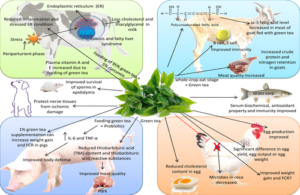Application of Tea and its residue in Livestock production
Abstract–
Tea is one of the most popular beverages around the world. Tea, especially Green tea (Camellia sinensis) has numerous bioactive substances and has a lot of health benefits. It is known to have anti-oxidative, anti-stress, anti-inflammatory properties. The usage of tea and its byproducts is one of emerging concepts in livestock production.
Introduction
With the awareness and consciousness of people regarding health, wellness, nutrition, and immunity enhancers, green tea has seen a great surge of consumers, owing to its multiple health benefits. It is found to have anti-oxidative, anti-stress, anti-inflammatory, anti-arthritic, anti-carcinogenic, anti-microbial, resistance to capillary blood congestion, hypocholesterolemic, hypolipidemic,etc. properties. Green tea contains bioactive substances such as caffeine, L-theanine, polyphenols/ flavonoids, catechins.
L-theanine has been studied as a food additive and functional food in relation to human nutrition, and it has properties such as anti-cerebral ischaemia-reperfusion injury, stress-reducing, antitumour, anti-ageing and anti-anxiety activities.
Chemical composition and its benefits
Tea leaves have a useful content of Alkaloids (caffeine, theobromine, theophylline), amino acids, proteins, vitamins, tannins, polyphenols, volatile oil, and minerals.
The chemical composition and other properties of green tea by Abdo et al. (2010) found that air-dried green tea leaves contained 7.80% moisture, 92.20% dry matter, 82.40% organic matter, 18.15% crude protein, 8.72% ether extract, 19.32% crude fibre, 9.80% ash, 36.21% nitrogen free extract and 3002 kcal/kg calculated metabolisable energy (ME).

Flavonoids exhibit anticarcinogenic, antimutagenic, and cardioprotective effects which are generally associated with antioxidant properties.
Catechins are present in higher amounts in green tea as compared to black or oolong tea, and are capable of binding with minerals thereby influencing their metabolism and concentration.
According to certain researches, L-theanine has many beneficial effects, such as it can increase 5-HT level in mice, level of IgA in jejunum in chicken, enhanced production of cytokines and body weight gain in pigs. It also has neuroprotective properties in animals. It also reduces toxic side-effects of anticancer drugs in animals.
Application in Animals
The effects of feeding green tea and green tea grounded on animals are as follows-
- Cattle
A study by Wrinkler et al. (2015), where supplementing the Cow feed with a combination of 95% green tea and 5% curcumin extract to dairy cows could reduce inflammation and alleviate stressed ER condition in lactating cows. At post-partum, the milk had less level of cholesterol and triacylglycerol up to the third week postpartum compared to control cows.
In some other studies, it is also found that feeding green tea leaves increases vitamin A and E concentration in plasma, and decreases the methane gas emission from cattle.
2. Pig
Feeding Pigs with Green tea and green tea byproducts (GTB) shows to reduce the indices of lipid oxidation- thiobarbituric acid (TBA) content and thiobarbituric acid reactive substances (TBARS) value thereby improving meat quality. There’s an improved colour and aroma in the pork samples treated with GTB.
3. Goats
Green tea waste when fed along with whole-crop oat silage to goats, there’s an increased available crude protein and nitrogen retention, thus it acts as a protein supplement. There’s a reduction of crude fat and cholesterol content in the chevon.
4. Poultry
The supplementation of poultry feed with green tea byproducts, reduces the cholesterol level in meat and egg yolk. It also reduces the low density lipoprotein (LDL) but enhances the High density lipoprotein (HDL) and docosahexaenoic acid in blood. The feed conversion ratio of poultry is also increased. The numbers of microflora in the caecum decreased as a result of the antimicrobial effect of green tea. The albumen quality and percentage gets increased in the laying hens.
Conclusion
With the increased consumption of green tea by humans and using its leaves and residues for animals, there are positive results in certain fields of health and quality of livestock products. The property of green tea as an anti-stressor can act as a crucial role in the upcoming future of livestock industry, due to the global climate change and it can also act as an alternative to the commercial growth promoters present in the market as a natural and herbal substitute.
Acknowledgement
I want to express my gratitude to Dr. Biju Borah, PhD, Assistant Professor, Department of Veterinary & Animal Husbandry Extension Education, Lakhimpur College of Veterinary Science, for giving me the opportunity to learn, gain knowledge and write an article on the above mentioned topic.
Written By–
Arijit Kumar Singha
Student, 3rd year BVSc. and AH
Lakhimpur College of Veterinary Science
singhaarijit2001@gmail.com
References–
Alagawany M, Abd El-Hack ME, Saeed M, et al. Nutritional applications and beneficial health applications of green tea and L-theanine in some animal species: A review. J Anim Physiol Anim Nutr. 2020;104:245-256. https://doi.org/10.1111/jpn.13219
Khan, S.H., 2014, ‘The use of green tea (Camellia sinensis) as a phytogenic substance in poultry diets’, Onderstepoort Journal of Veterinary Research 81(1), Art. #706, 8 pages. http://dx.doi.org/10.4102/ojvr.v81i2.706
Wang and Xu: Utilization of tea grounds as feedstuff for ruminant. Journal of Animal Science and Biotechnology 2013 4:54.
https://doi.org/10.1186/2049-1891-4-54


